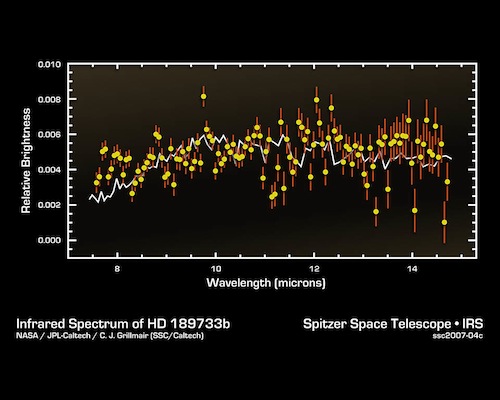PAOC Spotlights
Unlocking the Secrets of Starlight in the Search for Another Earth
When a planet outside our Solar System, or exoplanet, is big enough and orbits tightly enough around a star that’s bright enough, it’s an astronomer’s dream. That’s because it’s possible to find that planet’s mass. That measure could help researchers understand more of a planet’s properties because mass affects its plate tectonics, magnetism, and mineral composition, and ultimately, the potential to support life.
It’s currently possible to infer the mass of certain planets by measuring the slight changes in a star's spectrum, known as Doppler shift, due to a slight wobble that occurs as the star and the planet move about their common center of mass. However, this method, called radial velocity, is not suited for what astronomers really want to characterize in detail: Earth-size or smaller exoplanets or those orbiting faint or active stars.
Attaining the mass of potential Other Earths might have stayed out of science’s reach for decades if not for MassSpec, a concept for a mathematical method developed by graduate student Julien de Wit of Sara Seager’s research group in MIT’s Program in Atmospheres, Oceans, and Climate and unveiled today in the journal Science.
MassSpec is a new way of gleaning specific planetary information from a planet’s transmission spectrum, which astronomers visualize from satellite data in the wavelength-dependence of the dimming of a distant star's light as an orbiting planet passes, or transits, in front of it (The bigger an planet or the more opaque the planet’s atmosphere, the more light it blocks). de Wit’s method claims the ability to infer both a planet’s mass and atmospheric properties from the transmission spectrum.
 As a visiting graduate student at MIT back in 2010, de Wit was developing a framework to search for biosignatures, such as oxygen or water vapor, in planetary atmospheres when he realized that a planet’s transmission spectrum contained much more than he assumed: a hidden code for a planet’s mass.
As a visiting graduate student at MIT back in 2010, de Wit was developing a framework to search for biosignatures, such as oxygen or water vapor, in planetary atmospheres when he realized that a planet’s transmission spectrum contained much more than he assumed: a hidden code for a planet’s mass.
After showing that a planet’s mass is embedded together with other atmospheric properties in its transmission spectrum, De Wit knew he had to demonstrate that the mass could indeed be extracted from the spectrum independently—that no other parameter affects the atmosphere in the same way. “It’s like you are in a room with different musical instruments and a microphone that records the noise level,” explains de Wit. “You won’t be sure which instrument is playing—but if you actually record the sound, then you can identify a guitar, for example.” He found out that the key to reveal how each of these planetary properties affects the transmission spectrum is the special real number called the Euler-Mascheroni constant, first estimated in 1734. With this constant used in his equations, the data set gleaned from an exoplanet's spectrum is more like a sound recorder than a simple indicator of noise.
To test his method, de Wit applied the numerical method to a gas giant exoplanet, known as 189733b, that lives 63 light-years away. From his calculations, de Wit came up with the very same mass that others have found using radial velocity.
The implication of that finding is a huge boon to exoplanetology: a two-for-one deal: two planetary properties within just one type of data. “This tool will yield the mass and atmospheric properties of Earth-sized exoplanets in habitable zones, possibly allowing us to determine their habitability. And so, MassSpec could apply to the first Earth-sized exoplanet to be proven suitable for life,” says de Wit.
To apply to Earth-size planets, MassSpec demands data of higher signal-to-noise ratio and higher resolution than current telescopes, such as the Spitzer Space Telescope, delivers. Fortunately, these spectra are on the way, promised by next-generation telescopes such as the James Webb Space Telescope that’s scheduled to launch in 2018.
MassSpec is fascinating to scientists who are searching for Earth-size exoplanets in the Milky Way Galaxy, especially those orbiting in habitable zones, or the “Goldilocks” regions around stars that are not too hot, not too cold, and with enough atmospheric pressure to support liquid water or oceans (There are estimated to be as many as 40 billion). Astrophysicist Michaël Gillon of the Université de Liège in Belgium leads SPECULOOS (Search for Habitable Planets Eclipsing Ultra-Cool Stars), a ground-based telescope mission of the European Research Council, which will start to detect the nearest Earth-size planets predicted to be transiting tiny, ultra-cool (relative to our Sun) stars in 2015. “Applying Mass Spec, we should be able to get the mass of these planets without needing radial velocity measurements, and this will be very interesting for the science,” he says.
In fact, MassSpec extends the scientific capabilities of any future telescope initially designed for atmosphere characterization, such as the Exoplanet Characterisation Observatory (ECHO) led by astrobiologist Giovanna Tinetti. This 2024 mission will investigate the atmospheres of known exoplanets using spectroscopy, looking specifically for chemical signatures of life.
Sara Seager, Professor of Planetary Science and Physics at MIT, who worked with de Wit on MassSpec, often remarks that “for exoplanets, anything is possible under the laws of physics and chemistry.” Anything is possible, even life like ours, but to find it astronomers have to be able to better interpret the Rosetta Stones of transmission spectra from transiting exoplanets. As Gillon says, referring to the future results of MassSpec: “We’ll see what we get—whether we see life or not, we’ll still get the opportunity to find something.”
Watch Sara Seager's lecture Exoplanets and the Search for Habitable Worlds from Linda Hall Library on Vimeo.